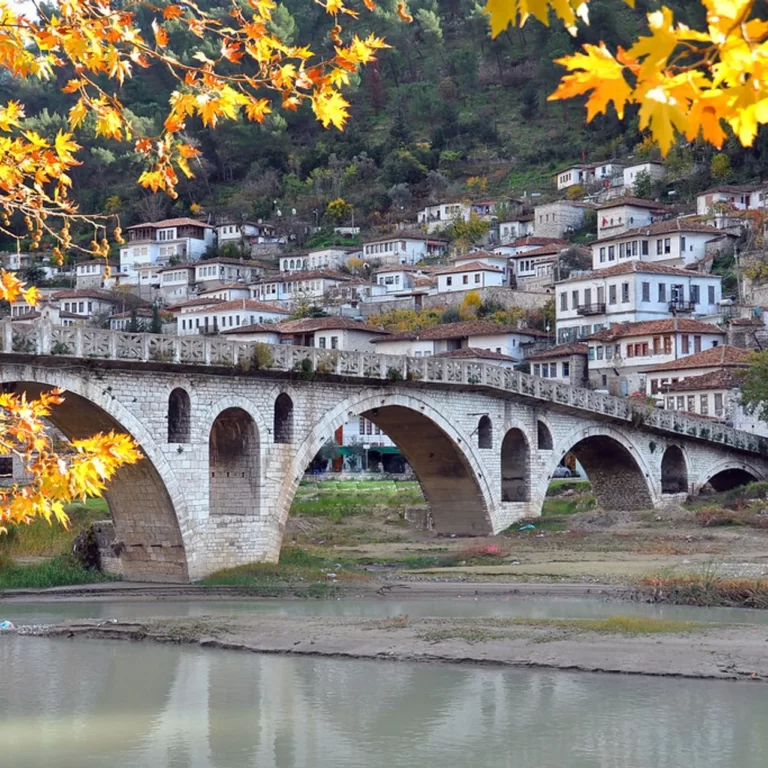

Berat (pronounced [bɛˈɾat]; Albanian definite form: Berati) is the ninth most populous city of Albania and the seat of Berat County and Berat Municipality.[2] By air, it is 71 kilometres (44 miles) north of Gjirokastër, 70 kilometres (43 miles) west of Korçë, 70 kilometres (43 miles) south of Tirana, and 33 kilometres (21 miles) east of Fier.
Berat is located in the south of the country. It is surrounded by mountains and hills, including Tomorr on the east that was declared a national park. The river Osum (total length 161 km (100 mi)) runs through the city before it empties into the Seman within the Myzeqe Plain. The municipality of Berat was formed at the 2015 local government reform by the merger of the former municipalities Berat, Otllak, Roshnik, Sinjë, and Velabisht, that became municipal units. The seat of the municipality is the city Berat.[2] The total population is 60,031 (2011 census),[a][4] in a total area of 380.21 km2 (146.80 sq mi).[5] The population of the former municipality at the 2011 census was 32,606.[4]
Berat, designated a UNESCO World Heritage Site in 2008, comprises a unique style of architecture with influences from several civilizations that have managed to coexist for centuries throughout the history. Like many cities in Albania, Berat comprises an old fortified city filled with churches and mosques painted with grandiose wealth of visible murals and frescos. Berat is one of the main cultural centres of the country.[6]
Ceramic finds from the 7th century BCE initially attest to a settlement of the rocky hill of Berat by the Illyrians.[12] Berat has been identified with ancient Antipatrea.[13] Probably since the mid-4th century BCE the Illyrians went through a dynamic development, founding their own cities like Dimale and Byllis; however it is uncertain whether this development among Illyrians involved also Berat, or whether the foundation of the city is to be attributed to Cassander of Macedon.[14] The founding date is unknown, although if Cassander is the founder, it would date back after he took control of southern Illyria around 314 BCE.[13]
Antipatrea was involved in the Illyrian Wars and Macedonian Wars,[15] and it is mentioned as a city of Dassaretia in southern Illyria. Along with Chrysondyon, Gertous and Creonion, Antipatrea was one of the Dassaretan towns around which the Illyrian dynast Skerdilaidas and the Macedonian king Philip V fought in 217 BCE. The city eventually was conquered by Philip V until Roman intervention.[16][17] Antipatrea was described as the largest settlement with significant walls and referred to as the only urbs in the area, in contrast with other settlements that were described as castella or oppida.[18] As reported by Roman historian Livy, in 200 BCE the Roman legatus Lucius Apustius “stormed and subdued Antipatrea by force of arms and, after killing the men of military age and granting all the plunder to the soldiers, he demolished the walls and burned the city”.[19][15] In Roman times it was included within Epirus Nova, in the province of Macedonia.[20] The town became part of the unstable frontier of the Byzantine Empire following the fall of the western Roman Empire and, along with much of the rest of the Balkan peninsula, it suffered from repeated invasions by Slavs. During the Roman and early Byzantine period, the city was known as Pulcheriopolis.
The First Bulgarian Empire under Presian I captured the town in the 9th century, and the city received the Slavic name Bel[i]grad (“White City”), Belegrada (Βελέγραδα) in Greek, which persisted throughout the medieval period, changing to Berat under Ottoman rule. The town became one of the most important towns in the Bulgarian region Kutmichevitsa. The Bulgarian governor Elemag surrendered the city to the emperor Basil II in 1018, and the city remained in Byzantine hands until the Second Bulgarian Empire retook the city in 1203 during the rule of Kaloyan. During the 13th century, it fell to Michael I Ducas, the ruler of the Despotate of Epirus.
Byzantine Emperor Michael VIII Palaiologos sent letters to the Albanian leaders of Berat and Durrës in 1272 asking them to abandon their alliance with Charles I of Naples, leader of the Kingdom of Albania, who had captured and incorporated it at the same period in the Kingdom of Albania.[21][22][23] However, they sent the letters to Charles as a sign of their loyalty.[24] In 1274 Michael VIII recaptured Berat and after being joined by Albanians who supported the Byzantine Empire, marched unsuccessfully against the Angevin capital of Durrës.[25] In 1280-1281 the Sicilian forces under Hugh the Red of Sully laid siege to Berat. In March 1281 a relief force from Constantinople under the command of Michael Tarchaneiotes was able to drive off the besieging Sicilian army.[26] Later in the 13th century Berat again fell under the control of the Byzantine Empire.
